Cabinet of Prince Qing
The Cabinet of Prince Qing (庆亲王内阁; 慶親王內閣; Qìng Qīnwáng Nèigé) was the first cabinet of the Qing dynasty and of China, formed as part of the Qing state's reforms to create a constitutional monarchy in the early 20th century. It was active from 8 May to 1 November 1911, led by the Prime Minister of the Imperial Cabinet, Yikuang (Prince Qing). It initially consisted of thirteen members, of which nine were Manchus (seven of whom were from the imperial clan) while only four were Han Chinese. As a result, it remained unpopular among the people and was nicknamed the "Princes' Cabinet" or "Imperial Family Cabinet"(皇族内阁; 皇族內閣; Huángzú Nèigé) by its critics.[1]
Cabinet of Prince Qing | |
|---|---|
1st Cabinet of China | |
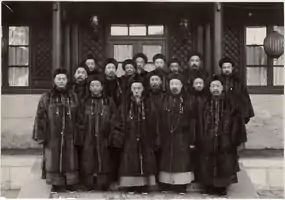 | |
| Date formed | 8 May 1911 |
| Date dissolved | 1 November 1911 |
| People and organisations | |
| Head of state | Xuantong Emperor |
| Head of government | Prince Qing |
| No. of ministers | 13 |
| History | |
| Election(s) | Appointed by the Emperor |
| Predecessor | None |
| Successor | Yuan Shikai's Cabinet |
History
The Imperial Cabinet was formed as a result of the constitutional reforms, the New Policies, being enacted in China in the early 20th century. It replaced the Grand Council, although it was unpopular and was described as "the old Grand Council under the name of a cabinet, autocracy under the name of constitutionalism."[1]
Members of the provisional assemblies, which were formed in 1908–09, protested against the formation of this cabinet. On 12 May, the Federation of Provincial Assemblies declared that imperial princes should not serve as premiers and that the Princes' Cabinet is not compatible with a constitutional monarchy. On 5 July, over 40 legislators submitted a petition to form a new cabinet. The imperial court responded with an edict which stated that assemblymen should not interfere with the appointment and dismissal of officials.[1]
The Princes' Cabinet was dissolved in November 1911 when Prince Qing resigned and his ally, general Yuan Shikai, was appointed prime minister in his place, establishing the Yuan Cabinet.[1]
Composition
The following is the list of cabinet ministers. Unless otherwise noted, their term began on 8 May and ended on 1 November when the cabinet was dismissed.
| Office | Name | Portrait | Ethnicity | Notes |
|---|---|---|---|---|
| Prime Minister | Yikuang, Prince Qing 慶親王 奕劻 | 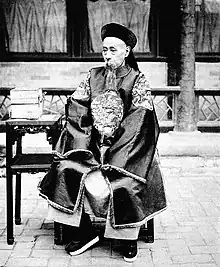 | Manchu | |
| Minister of the Cabinet | Natong 那桐 |  | Manchu | |
| Xu Shichang 徐世昌 |  | Han Chinese | ||
| Minister of Foreign Affairs | Liang Dunyan 梁敦彥 | 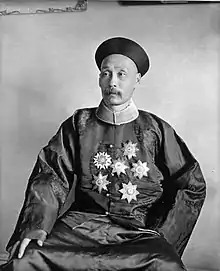 | Han Chinese | |
| Minister of Internal Affairs | Shanqi, Prince Su 肅親王 善耆 |  | Manchu | Appointed on April 10 |
| Guichun 桂春 | Manchu | Acting | ||
| Zhao Bingjun 趙秉鈞 | 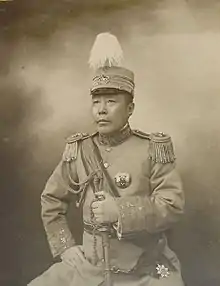 | Han Chinese | Appointed in early October | |
| Minister of Finance | Zaize, Grace Defender Duke 奉恩鎮國公 載澤 | .jpg.webp) | Manchu | |
| Minister of Education | Tang Jingchong 唐景崇 |  | Han Chinese | |
| Minister of the Army | Yinchang 蔭昌 |  | Manchu | |
| Minister of the Navy | Zaixun, Prince Rui 瑞郡王 載洵 | 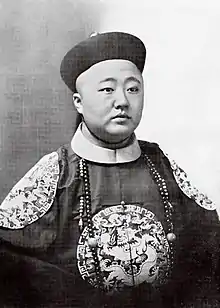 | Manchu | |
| Minister of Justice | Gioro Shaochang 覺羅紹昌 | Manchu | ||
| Minister of Agriculture, Industry, and Commerce | Pulun, Beile-ranked beise 貝子加貝勒銜 溥倫 |  | Manchu | |
| Minister of Mail and Communications | Sheng Xuanhuai 盛宣懷 |  | Han Chinese | |
| Tang Shaoyi 唐紹儀 | 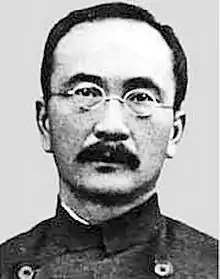 | Han Chinese | Appointed on September 5 | |
| Minister of the Lifan Yuan | Shouqi 壽耆 |  | Manchu | |
| Shanqi, Prince Su 肅親王 善耆 |  | Manchu | Appointed on June 21 |
References
Further reading
- Esherick, Joseph (2013). China: How the Empire Fell. New York: Routledge. ISBN 978-0415831017.